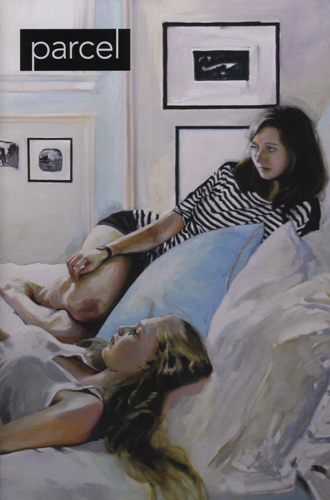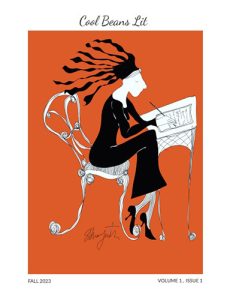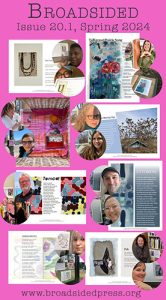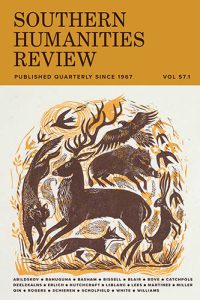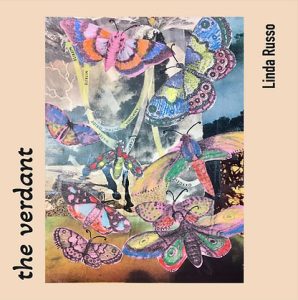Parcel – Fall/Winter 2014
The slim, new issue of Parcel is filled with experimental poetry and fiction, about half and half. The magazine’s website, however, says it has “international aspirations and an interest in a broad range of poetry, prose and art.” And though this issue has no essays, the editor’s note: “we have a special interest in lyric essays and essays that explore innovative forms and structures.” The slim, new issue of Parcel is filled with experimental poetry and fiction, about half and half. The magazine’s website, however, says it has “international aspirations and an interest in a broad range of poetry, prose and art.” And though this issue has no essays, the editor’s note: “we have a special interest in lyric essays and essays that explore innovative forms and structures.”
Parcel is published by Heidi Raak, owner of the independent Raven Book Store in Lawrence, Kansas. The magazine staff is just two people, Editor Kate Lorenz and Poetry Editor Justin Runge. The editors, like all but one of the contributors, have many publication credits, and quite a few have an MFA degree, or they are earning one.
The literary experiments that make up Parcel are in the vein of surrealism, symbolism, use of dialect, and a kind of repetition that recalls Gertrude Stein. Sara Peck and Jessica Bixel put vivid images in their poems but banish punctuation and sensibility. The poem “Golem” by Laura Kochman uses the well-known image of the Jewish statue brought to life. Greg Bachar in his five one-page pieces does a convincing imitation of Finnegan’s Wake, by James Joyce, with scenes and monologues about dying, and with characters named Werther, Cantabee and The Neezer.
Poems by Terrell Jamal Terry and Daniel Sack are more conventionally composed. “Imagined Theatre #6” by Sack rests on a single image, set forth in the first stanza:
The curtain opens endlessly;
it does not stop at the proscenium’s
jamb, but instead runs on.
The last stanza has the line “crimson velvet ouroboros,” which is a great word to know: “snake eating its tail,” an image for self-renewal.
The longest piece “Where Then Can I Go” by Travis Vick is a fictional monthly journal of a death row inmate, extending through a year and ending with his execution. Most of the entries are in the voice of the inmate, Tyler Gilmore. Realistic description of his life in prison includes dialogue with guards, a therapist, and another inmate, Greg. The last two entries are letters Greg writes to Tyler after he has been executed. The piece is moving and unnerving, but I’m not fully sure what the author want readers to make of it.
Some pieces hover between poetry and prose, a form that some call “hybrid.” Kristen Gleason in “Fringe” contributes seven pages which begin: “The fringe-footed pony dancers performed in the courtyard.” There is a barber named Goro, a Colonel, a flying bird, and a narrator named Noll, who has a pike and a skewered gourd, though what happens in this surrealist story is unclear. Linda Sexson has three short pieces, a page or two each, which are perhaps meant to be read together. They are full of sharp detail and powerful symbols, but the story is opaque.
“Turtle Eggs” by Allegra Hyde is the closest thing to a conventional short story. At three pages, it suggests more than it tells, but Hyde works economically. A group of college seniors rents a Carolina beach house for a week before graduation in 1990. Heavy drinking ensues, and they watch a sea turtle lay eggs in the sand. Decades of success and failure follow, including one suicide. “Years later, they would wish they could follow the moon. Something, anything, to return them to the in-betweeness of that week.”
Nick Francis Potter provides a lighter touch in “Debbie,” which eludes category. “I have a Debbie in my life—a friend-Debbie—which isn’t unusual,” it begins. The piece riffs on “Platonic Debbie,” who feeds her daughter “ghost toast” and in some way is “running low on energy.” Death lurks in “Debbie,” but toward the end the narrator says: “I think family is survival. Perhaps love too, then.”
In addition to the writing, a full-color spread of paintings occupies the middle, and a painting by the same artist, Juliana Romano, is on the cover. All the images show young women in a semi-abstract style in poses of relaxation. They are lovely but withdrawn. Romano says: “I get lost in a kind of half-repressed, half bubbling-over Victorian prettiness—damp, red-rimmed eyes and flushed cheeks.”
From slightly more traditional pieces to hybrid experiments, this issue of Parcel explores the light and dark, the realistic and surreal, successfully meeting their goal of publishing a broad range of work.
[www.parcelmag.org]

